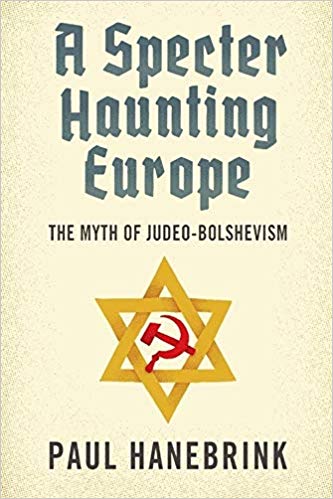Zydokomuna Denialism Rests Largely on Holocaust Supremacism Hanebrink

A Spectre Haunting Europe: The Myth of Judeo-Bolshevism, by Paul Hanebrink. 2018
Self-Refuting. Evidently, “Coming to Terms With the Past” is Good for Non-Jews But Not For Jews: A Creative Dodge From the Undeniable Large Scale Jewish Complicity in Communism
This book is of little value. Let us, however, begin with a positive note.
RED=BROWN (NAZI=SOVIET) IS A THREAT TO HOLOCAUST SUPREMACISM: A CANDID ADMISSION
Consider what has become known as double genocide. Paul Hanebrink takes up the cases of Ernst Nolte and Arno Mayer with a candid admission of the reason that many Jews are so afraid of the crimes of the Communists getting more recognition in western popular cultures. He writes, “Examining the entanglement of Nazi and Soviet violence during wartime also made it increasingly difficult to conceptualize the Holocaust as a distinct historical event, upending arguments on which its status as the paradigmatic genocide rested.” (p. 251). Absolutely! It can finally remove the Holocaust from the throne on which it does not belong: No one’s genocide does.
On a related note, Hanebrink restates the oft-repeated falsehood that Poland’s postwar government treated Polish and Jewish deaths, at the hands of the Nazis, as one and the same. (p. 196). It did not: It merely refused to treat Jewish deaths as something special, which is the cornerstone of the Holocaust supremacism that–BTW–did not become dominant until decades after World War II.
ZYDOKOMUNA NEGATIONISM: THE AUTHOR’S IDEOLOGICALLY-DRIVEN DODGES AND DEFLECTIONS
Instead of confronting the criminality of Communism (especially Jewish Communism), author Paul Hanebrink consistently tries to discredit this very-real issue associating it with the “bad smell” of conspiracy theories and the presumed constant GOYISCH need to make a scapegoat out of the ever-innocent Jew.
He then “updates” this classic deflection by trying to associate discussion of Jewish Communism with the “bad smell” of leftist-disliked movements, such as the revived European nationalism and the very-rational opposition to forced immigration. To make the discussion even more taboo, he tries to connect it to really smelly things–neo-fascism (what else?), anti-Islamism, and—still better–racism and white supremacism. (pp. 1-3; pp. 274-282). In fact, he insinuates that memories of Soviet terror are, or may be, in his words, “irredeemably tainted” by the way that anti-Communism, anti-Semitism, and racism were “so often fused” together. (p. 243). How convenient!
THE CANNED EXCULPATORY MEMES FOR THE ZYDOKOMUNA
Although this book relies more on dodges than exculpations for the Zydokomuna, Hanebrink is not above using the latter, including some rather juvenile ones. He dutifully reminds us that “most Jews had never been Communists” (p. 140) as if it made the slightest difference. (Imagine someone saying that there was no Japanese attack on Pearl Harbor, because, after all, not all of the 100 million Japanese had boarded planes and bombed Pearl Harbor. Only a tiny fraction had done so.)
Paul Henebrink characterizes the Jewish involvement in Communism with these flowery words, “All believed in the power of ideas to transform the world; all saw a future filled with limitless possibility; all were convinced in the rightness of their beliefs.” (p. 25). But so did the Nazis! A Jew joining the Communists was knowingly involved in a criminal movement as much as a German joining the Nazi Party was knowingly involved in a criminal movement.
The author repeats the non sequitur argument that Jewish votes for the Communist Party, in pre-WWII Poland, were often in the single-digit range. (p. 21). This, among other things, ignores the fact that Jewish support for Communism was usually covert, and otherwise disguised within mainstream Jewish socialist and Zionist movements. And why waste one’s vote for a party that has almost no chance of coming to power through free elections—least of all likely in pre-WWII Poland?
When all else fails, Hanebrink dusts off the “Jewish Communists were not really Jews” exculpation. (e. g., pp. 23-on). So what were they—Martians? Fact is, anyone born to a Jewish mother who does not convert to another religion is a Jew: Whether or not the person observes Jewish customs, and is or is not assimilated, are irrelevant. Nor has the Jewish community disowned Jewish Communists. For example, Jewish Communists have been buried in Jewish cemeteries, and the State of Israel has welcomed Jewish Communists as valid Jews, even enabling some of them (e. g, Butcher of Poles Salomon Morel) to escape justice for their crimes.
SO COMMUNISM WAS LITTLE MORE THAN A BAD COLD. WOW!
A major theme of this book is the attempt to make Communism into nothing more than a bogeyman. That way, the Jewish complicity in Communism can be spun as something that is no big deal. Henebrink, until the end of his book and then barely, seems to have a very hard time getting a grip on the criminality of Communism, under which tens of millions of people were murdered. He even uses exculpatory Orwellian language—referring to the “Soviet experiment” (p. 67, 105). Nice choice of words. Now imagine someone referring to the Third Reich as “the Nazi experiment”.
To see a series of truncated reviews in a Category click on that Category:
- All reviews
- Anti-Christian Tendencies
- Anti-Polish Trends
- Censorship on Poles and Jews
- Communization of Poland
- Cultural Marxism
- German Guilt Dilution
- Holocaust Industry
- Interwar Polish-Jewish Relations
- Jewish Collaboration
- Jewish Economic Dominance
- Jews Antagonize Poland
- Jews Not Faultless
- Jews' Holocaust Dominates
- Jews' Holocaust Non-Special
- Nazi Crimes and Communist Crimes Were Equal
- Opinion-Forming Anti-Polonism
- Pogrom Mongering
- Poland in World War II
- Polish Jew-Rescue Ingratitude
- Polish Nationalism
- Polish Non-Complicity
- Polish-Ukrainian Relations
- Polokaust
- Premodern Poland
- Recent Polish-Jewish Relations
- The Decadent West
- The Jew as Other
- Understanding Nazi Germany
- Why Jews a "Problem"
- Zydokomuna